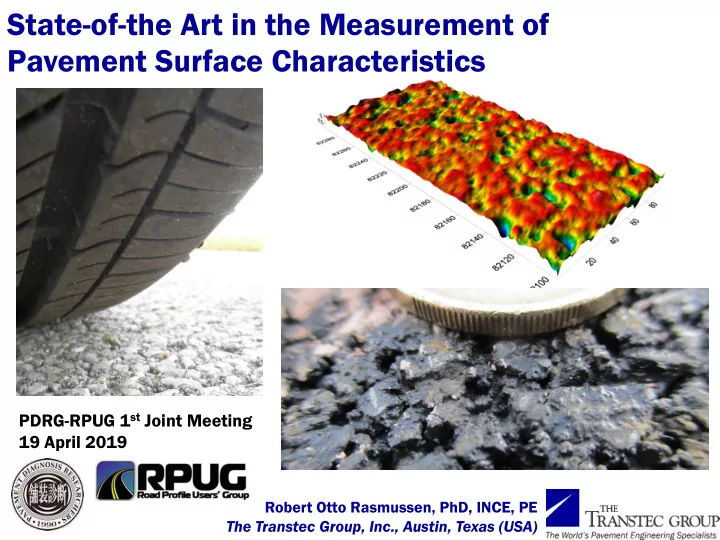

State-of-the Art in the Measurement of Page 1 Pavement Surface Characteristics PDRG-RPUG 1 st Joint Meeting 19 April 2019 Robert Otto Rasmussen, PhD, INCE, PE The Transtec Group, Inc., Austin, Texas (USA)
What are Pavement Surface Characteristics? Page 2 • Vehicle/tire interactions with the road surface: – Noise & vibration – Braking – Steering & handling – Ride quality (evenness) – Hydroplaning – Rolling resistance (fuel consumption) – Tire wear – Vehicle durability
What are Pavement Surface Characteristics? Page 3 Human Experience & Societal Demands Users & Society Friction Pavement Surface Evenness Characteristics Splash & Spray Noise Roll. Res. Stiffness Porosity Pavement Properties Texture Traffic Materials Foundation Factors Design Construction Climate Maintenance
Why do we Measure Pavement Surface Characteristics? Page 4 1. Evaluate conformance with requirements. a) Construction quality for acceptance. b) Periodic testing of performance requirements (PPP / JEHDRA). c) Laws and regulations (noise, friction, fuel economy). 2. Evaluate changes in pavement over time. a) Asset management 3. To improve road, vehicle, and tire engineering.
Texture Classifications for Pavement Surface Characteristics Page 5 Wavelength Texture 1 / 8 in. 0.1mil 1mil 10mil 1in. 1ft. 10ft. 100ft. 1 m m 10 m m 100 m m 1mm 10mm 100mm 1m 10m 100m Category Microtexture Macrotexture Megatexture Roughness PIARC Rolling Resistance Pavement Surface Characteristic (PSC) Ride Quality Wet Weather Friction Influence Dry Weather Friction Splash and Spray Tire Wear Vehicle Wear In-Vehicle Noise Key: Tire-Pavement Noise Good Bad Source: PIARC
Texture Classifications for Pavement Surface Characteristics Page 6 Rou ough ghness ness Meg Megat atextu xture re Mic Micro rotextu xture re Macr Ma crot otextu xture re
Measuring “Profiles” with Straightedges Page 7
Measuring Profiles with Inertial Profilers Page 8 Computer Accelerometer (inside van) Wheel Encoder Lasers (Distance Sensor) (Height Sensors)
Measuring Profiles with Inertial Profilers Page 9
Measurements of 3-D Profiles Page 10
Calculating Evenness from Profiles: International Roughness Index (IRI) Page 11 4 “Unacceptable” Ride 3 “Poor” Ride IRI (m/km) 2 “Average” Road Smooth/New Highway 1 Smoothest Automotive Proving Ground 0
Viewing and Analyzing Profiles for Evenness Page 12
Viewing and Analyzing Profiles for Evenness Page 13 What is causing this?
Viewing and Analyzing Profiles for Evenness Page 14 Several “bumps” of ~ 5 mm height
Analyzing Profiles for Construction Defects Page 15 Asphalt Trucks Asphalt Material Feed Grade Control Paver Stops
Measuring Profiles in Real-Time during Construction Page 16
Measurements for Texture Page 17 Page 17
Measurements for Texture: Old, Worn Asphalt Page 18
Measurements for Texture: Good, New Asphalt Page 19
Measurements for Texture: Variability in Surface Texture Page 20 Page 20 Mean Profile Depth, MPD (mm) Stone Loss (Raveling) Good Texture 0 100 200 300 400 500 600 700 800 900 Distance (m)
Measurements for Texture: Variability in Surface Texture Page 21 Page 21 Possible Causes of Raveling Raking of Loose Mix Excessive Mix Temperature
Measurements for Friction (Grip) Page 22
m Grip Measurements for Improving Pavement Engineering Page 23 Page 23 Sandstone Gabbro Slag Expanded Shale/Clay Granite Trap Rock Limestone A “cocktail” of aggregates can result in targeted grip levels. Also important to understand stability of grip with time.
Measurements for Tire-Pavement Interaction Noise Page 24
Tire-Pavement Interaction Noise Page 25 Quietest pavement we have measured: Precast Porous Concrete located in the Netherlands
Tire-Pavement Interaction Noise Page 26
Predicting Tire-Pavement Interaction Noise from Texture Page 27
Predicting Tire-Pavement Interaction Noise from Texture Page 28 112 Transverse Tining OBSI = f (L tx,160 , L tx,25 , R k,TR ) Transverse Tining 111 Longitudinal Tining Longitudinal Tining Texture-Predicted Site Average OBSI Level (dBA) OBSI = f (L tx,40 ) Drag 110 Diamond Grinding Diamond Grinding OBSI = f (L tx,80+63+50+40 , Skew TR ) 109 Drag 108 OBSI = f (L tx,50+40 , Skew TR , R k,TR ) 107 • L tx per ISO/CD 13473-4 (Draft) • R k,TR(ansverse) per ISO 13565-2 106 • Skew TR(ansverse) per ASME B46.1 105 +/- 1 dBA 104 103 102 1:1 Trendline R 2 = 0.87 101 StdErr = 0.9 dBA 100 100 101 102 103 104 105 106 107 108 109 110 111 112 Measured Site Average OBSI Level (dBA)
Measurements for Rolling Resistance Page 29
Measurements for Rolling Resistance Page 30 15% difference
Measurements for Rolling Resistance Page 31 Improper use of vibratory roller introducing texture
Texture Impacts on Rolling Resistance Page 32 Improper use of vibratory roller introducing texture
Pavement Management Page 33
Pavement Management Page 34
Pavement Management Page 35
Page 36 どうもありがとうございました Robert Otto Rasmussen, PhD, INCE, PE The Transtec Group, Inc., Austin, Texas (USA) Robotto@TheTranstecGroup.com +1 (512) 680 8362
Recommend
More recommend